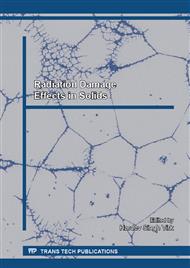[1]
R. H. Victora, Micromagnetic predictions for barium ferrite particles, J. Appl. Phys. 63(8), (1988) 3423-3428.
DOI: 10.1063/1.340755
Google Scholar
[2]
A. Ataie, I. R. Harris, and C. B. Ponton, Magnetic properties of hydrothermally synthesized strontium hexaferrite as a function of synthesis conditions, J. Mater. Sci. 30, (1995) 1429-1433
DOI: 10.1007/bf00375243
Google Scholar
[3]
T. M. H. Dang, V. D. Trinh, D. H. Bui, M. H. Phan and D. C. Huynh, Sol–gel hydrothermal synthesis of strontium hexaferrite nanoparticles and the relation between their crystal structure and high coercivity properties, Adv. Nat. Sci.: Nanosci. Nanotechnol. 3 (2012) 025015-21
DOI: 10.1088/2043-6262/3/2/025015
Google Scholar
[4]
A. Drmota, A. Žnidarši, Č. A. Košak, Synthesis of strontium hexaferrite nanoparticles prepared using co-precipitation method and microemulsion processing, J. Phys.: Conf. Ser. 200 (2010) 082005-8.
DOI: 10.1088/1742-6596/200/8/082005
Google Scholar
[5]
F. Studer, Ch. Houpert, D. Groult, J. Yun Fan, A. Meftah and M. Toulemonde, Spontaneous magnetization induced in the spinel ZnFe2O4 by heavy ion irradiation in the electronic stopping power regime, Nucl. Instr. Meth. B 82 (1) (1993) 91-102.
DOI: 10.1016/0168-583x(93)95087-l
Google Scholar
[6]
Anjana Dogra, Ravi Kumar, S.A. Khan, V.V. Siva Kumar, N. Kumar, M. Singh, Influence of 190 MeV Ag ion irradiation on structural and magnetic properties and oxygen content of NiMn0.05TixMgxFe1:95-2xO4 (x = 0.0, 0.2) ferrite thin film, Nucl. Instr. Meth. Phys. Res. B 225 (2004) 283–290.
DOI: 10.1016/j.nimb.2004.05.010
Google Scholar
[7]
B. Kaur, M. Bhat, F. Licci, R. Kumar, S. D. Kulkarni, P. A. Joy, K. K. Bamzai, P. N. Kotru, Modifications in magnetic anisotropy of M—type strontium hexaferrite crystals by swift heavy ion irradiation J. Magn. Magn. Mater. 305 (2) (2006) 392-402.
DOI: 10.1016/j.jmmm.2006.01.110
Google Scholar
[8]
B. Kaur, M. Bhat, F. Licci, R. Kumar, P. N. Kotru, K. K. Bamzai, Effect of 50 MeV Li3+ ion irradiation on mechanical characteristics of pure and Ga–In substituted M-type strontium hexaferrite, Nucl. Instr. Meth. Phys. Res. B 222 (1–2) (2004) 175-186.
DOI: 10.1016/j.nimb.2004.01.222
Google Scholar
[9]
S. R. Shinde, A. Bhagwat, S. I. Patil, S. B. Ogale, G. K. Mehta, S. K. Date, G. Marest, Influence of 85 MeV oxygen ion irradiation on magnetization behaviour of micron-sized and nano-sized powders of strontium ferrite (SrFe12O19), J. Magn. Magn. Mater. 186 (3) (1998) 342-348.
DOI: 10.1016/s0304-8853(97)01157-8
Google Scholar
[10]
N. R. Panchal, K. Asokan, R. B. Jotania, The effect of Ag16+ ion irradiation on the structural properties of Ba–W hexaferrite prepared using a co-precipitation route, Radiation Effects and Defects in Solids 166 (8-9) (2011) 653-656.
DOI: 10.1080/10420150.2011.578635
Google Scholar
[11]
J.F. Ziegler, Computer Code SRIM-2008.05, Available from: http://www.srim.org/.
Google Scholar
[12]
J. J. Temuujin, M. Aoyama, M. Senna, T. Masuko, C. Ando, H. Kishi, Synthesis of Y-type hexaferrites via a soft mechanochemical route, J. Solid State Chem. 177 (11) (2004) 3903-3908.
DOI: 10.1016/j.jssc.2004.06.051
Google Scholar
[13]
R. C. Pullar, M. D. Taylor, A. K. Bhattacharya, Aligned hexagonal ferrite fibres of Co2W, BaCo2Fe16O27 produced from an aqueous sol–gel process, J. Mat. Sci. 32 (1997) 873-877.
Google Scholar
[14]
Joint Committee on Powder Diffraction Standard (JCPDS), International Center for Diffraction Data.
Google Scholar
[15]
A. Deepthy, K. S. R. K. Rao, H. L. Bhat, R. Kumar, K. Asokan, Gray track formation in KTiOPO4 by swift ion irradiation, J. Appl. Phys. 89 (2001) 6560-6562.
DOI: 10.1063/1.1347949
Google Scholar
[16]
B. Angadi,V. M. Jali, M. T. Lagare, N. S. Kini, A. M. Umarji, R. Kumar, S. K. Arora, D. Kanjilal, 50 MeV Li3+ irradiation effects on the thermal expansion of Ca1−xSrxZr4P6O24, Nucl. Instrum. Meth. B, 187 (1) (2002) 87-94.
DOI: 10.1016/s0168-583x(01)00847-3
Google Scholar
[17]
R. Bathe, S. K. Date, S. R. Shinde, L. V. Saraf, S. B. Ogale, S. I. Patil, R. Kumar, S. K. Arora, G. K. Mehta, 90 MeV 16O ion irradiation effects on transport and magnetization in epitaxial thin films of La0.75Ca0.25MnO3, J. Appl. Phys. 83 (1998) 7174-7176.
DOI: 10.1063/1.367792
Google Scholar
[18]
B. P. Rao, K. H. Rao, P.S.V. Subba Rao, A. M. Kumar, Y. L. N. Murthy, K. Ashokan, V. V. Siva Kumar, Ravi Kumar, N. S. Gajbhiye, O. F. Caltum, Swift heavy ions irradiation studies on some ferrite nanoparticles, Nucl. Instrum. Meth. B, 244 (1) (2006) 27-30.
DOI: 10.1016/j.nimb.2005.11.009
Google Scholar
[19]
F. Seitz, On the disordering of solids by action of fast massive particles, Discuss. Farady Soc. 5 (1949) 271-282.
DOI: 10.1039/df9490500271
Google Scholar
[20]
C.G. Koops, On the Dispersion of Resistivity and Dielectric Constant of Some Semiconductors at Audiofrequencies, Phys. Rev. 83 (1951) 121-124.
DOI: 10.1103/physrev.83.121
Google Scholar
[21]
M.A. Madare, S.V. Salvi, Investigation of electrical and dielectric properties of "modified" iron titanates, Ind. J. Phys. 75A (4) (2001) 363-366.
Google Scholar
[22]
Z.W. Li, C.K. Ong, Z. Yang, F.L. Wei, X.Z. Zhou, J.H. Zhao, A.H. Morrish, Site preference and magnetic properties for a perpendicular recording material: BaFe12-xZnx/2Zrx/2O19 nanoparticles, Phys. Rev. B 62 (10) (2000) 6530-6537.
DOI: 10.1103/physrevb.62.6530
Google Scholar
[23]
G. Fuchs, F. Studer, E. Balanzat, D. Groult, M. Toulemonde, J.C. Jousset, Influence of the Electronic Stopping Power on the Damage Rate of Yttrium-Iron Garnets Irradiated by High-Energy Heavy Ions, Europhys. Lett. 3 (3) (1987) 321-327.
DOI: 10.1209/0295-5075/3/3/012
Google Scholar
[24]
A. Fnidiki, J. Juraszek, J. Teillet , Magnetic composite materials obtained by swift heavy-ion irradiation of yttrium iron garnet ceramics, Appl. Phys. Lett. 75 (1999) 1296-1298.
DOI: 10.1063/1.124673
Google Scholar


